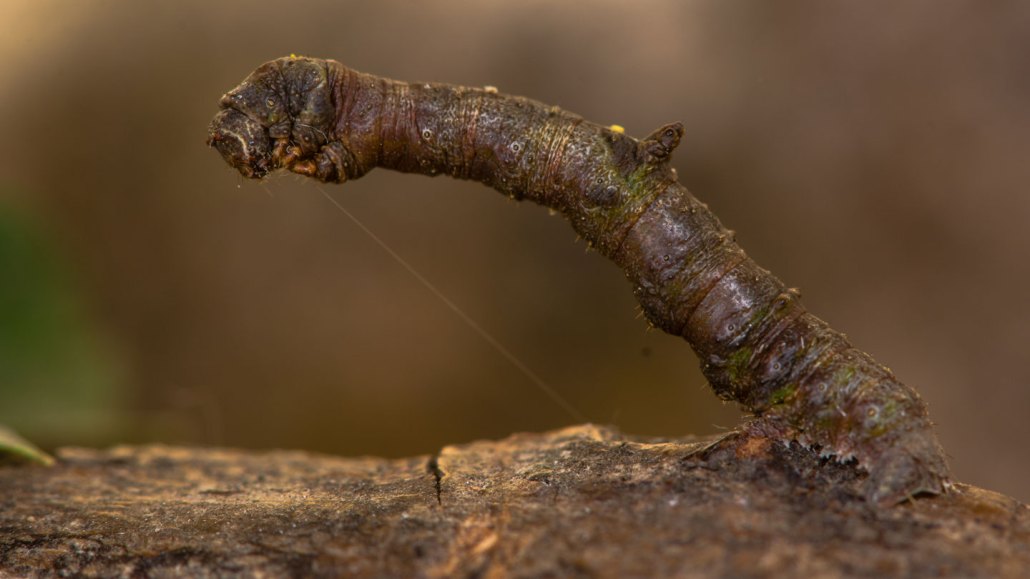
Caterpillars that masquerade as leaves or twigs, like this brimstone moth caterpillar (Opisthograptis luteolata), appear most effective at evading recognition by predators.
Ian_Redding/iStock/Getty Images Plus
From crabs to caterpillars, a wide range of animals successfully use camouflage to hamper detection by hungry predators. But some concealment strategies are more effective than others, a new study suggests.
The analysis compiles and synthesizes data from scores of studies on animal camouflage. Comparisons between different camouflaging methods show that masquerading as specific objects in the environment is the best way to go unseen, scientists report September 14 in Proceedings B of the Royal Society.
Behavioral and sensory ecologist João Vitor de Alcantara Viana had been studying animal camouflage for his doctoral research when he realized a comprehensive comparison of different camouflage strategies had never been done.
“There was a big gap in the literature on this topic,” says de Alcantara Viana, of the State University of Campinas in São Paulo, Brazil.
So, de Alcantara Viana and colleagues searched scientific publication databases for studies on animal camouflage dated from 1900 through July 2022. The team zeroed in on 84 studies that experimentally tested at least one camouflage strategy, and reported either how long predators took to find camouflaged prey or how often predators attacked. The team also limited their analysis to studies that compared camouflaged prey with noncamouflaged, often artificial, versions.
Next, the team grouped the data from these studies by the types of predators and prey analyzed and the variety of camouflage strategies examined. Camouflage tactics included “background matching,” where the animal matches the color and patterning of the environment, and “masquerading,” where prey mimics a particular object uninteresting to predators, like a twig, a leaf, a bird dropping or even a shed tarantula skin (SN: 12/10/13; SN: 6/6/14).
Camouflage is generally effective at making the hunt difficult for predators, increasing their search time by more than 62 percent and dropping the rate they attack prey by more than 27 percent across the board, the team found.
But the type of prey mattered. Caterpillars got more benefit from camouflage than their winged adult forms, for example. This may be because moths and butterflies can fly and have other antipredator adaptations available to them, de Alcantara Viana says.
The masquerade strategy was especially effective at helping prey elude predators, increasing search time by nearly 300 percent. One of the most striking examples of this, says de Alcantara Viana, are caterpillars that disguise themselves as twigs. A study on brimstone moth caterpillars (Opisthograptis luteolata) and chickens showed that the birds take longer to attack masquerading caterpillars after being recently exposed to twigs.
Masquerading as the most effective camouflage strategy is intriguing, says Anna Hughes, a sensory ecologist at the University of Essex in England who was not involved with this research. “If this is indeed the case, it will be interesting to further investigate the constraints — size, movement requirements — that mean that not all animals evolve this strategy,” she says. The researchers note that masquerading is probably more likely to evolve if the animal is a similar size as the object it’s mimicking. This could limit what species can benefit from this super camo.
de Alcantara Viana and his colleagues think masquerading is so effective because it’s so specialized, with animals impersonating specific objects, compared with other strategies based on blending in against an irregular background. Prey that masquerade benefit from the predator misidentifying them as real objects in the environment, not just failing to detect the prey.
The quality of the new work is excellent, Hughes says. Still, it’s not quite clear if the noncamouflaged controls, which she says vary quite widely from one study to another, have inherently different effects on predator reactions. This could make the tested camouflage seem more or less effective than it is in nature.
Another notable finding from the new analysis is that most studies have been conducted in the Northern Hemisphere, Hughes says. “I think it is clear that our understanding of the evolution of camouflage strategies is going to be, by definition, incomplete unless more studies are carried out in the Southern Hemisphere.”
Much of recent camouflage research has also tried to understand precisely how specific defenses protect prey from attacks, says Tom Sherratt, an evolutionary ecologist at Carleton University in Ottawa, Canada, also not involved with this study.
“We are now at a point where we can begin to compare among these defenses,” Sherratt says, which can help researchers figure out why species use particular camouflage strategies.
de Alcantara Viana says he and his colleagues are working on another analysis to understand “the other side of the coin,” how camouflaged predators benefit from concealing themselves from prey.






